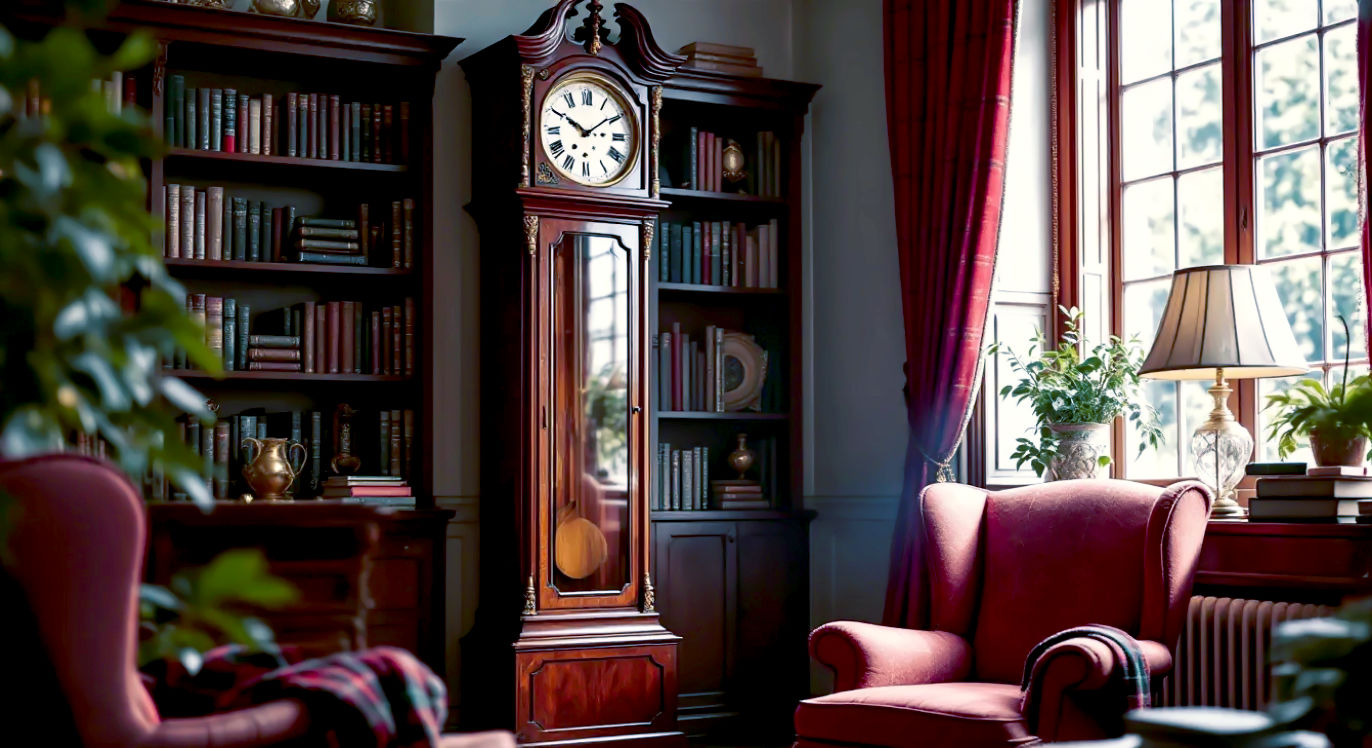Tick-Tock: The UK Guide to Floor and Grandfather Clocks
The definitive guide to tall clocks. Discover the rich history of British longcase clocks, learn the true difference between a floor and a grandfather clock, and find the perfect timepiece for your home.

This post may contain affiliate links. If you make a purchase through these links, we may earn a commission at no additional cost to you.
Picture a quiet hallway in a British home. The air is still, save for one sound: a steady, reassuring tick-tock. It’s the heartbeat of the house, a sound that has measured out moments—from quiet Sunday afternoons to bustling Christmas mornings—for generations. This sound almost certainly comes from a tall, elegant clock standing sentinel against the wall. But what do you call it? Is it a floor clock? A grandfather clock? A longcase clock?
It’s a simple question, but one that opens a door into a fascinating world of history, engineering, and artistry. Many people use the terms ‘floor clock’ and ‘grandfather clock’ as if they mean the same thing. And in a way, they’re not entirely wrong, but they’re not completely right either. It’s a bit like calling every fizzy drink ‘Coke’.
So, what’s the real story? Which is which, when should you use each term, and why does it all matter? This is the definitive guide to understanding these magnificent timepieces. We’ll untangle the names, explore their incredible journey from scientific breakthrough to beloved family heirloom, and give you the practical advice you need to choose, buy, and care for one in your own home. Get ready to discover why these gentle giants have been capturing British hearts for over 350 years.
The Big Question: What’s in a Name?
Let’s clear this up right away. It’s simpler than you think.
Think of ‘floor clock’ as the big family name. It’s the correct, catch-all term for any tall, freestanding clock that is designed to stand on the floor. If it’s tall and tells the time from the ground up, it’s a floor clock. This category includes every style, from the grandest antique to the sleekest modern design.
So, where does the ‘grandfather’ come in?
It’s All Thanks to a Song
The term ‘grandfather clock’ is actually a nickname, and a surprisingly recent one at that. For most of their history, these clocks were called longcase clocks or tall-case clocks. The name was purely descriptive: they had a long case to protect a very long pendulum.
The name we use today comes from a song written in 1876 by an American songwriter named Henry Clay Work. The song, titled “My Grandfather’s Clock”, was a massive hit on both sides of the Atlantic. It tells the sentimental story of a clock that was bought on the morning of the narrator’s grandfather’s birth and worked perfectly for 90 years, only to stop forever the moment the old man died.
“But it stopped short — never to go again — When the old man died.”
The song was so popular that the term ‘grandfather clock’ stuck. People started referring to all longcase clocks by this affectionate nickname. So, strictly speaking, a grandfather clock is a type of floor clock, specifically the traditional, pendulum-driven kind that the song described.
Meet the Rest of the Family: Grandmother and Granddaughter Clocks
Once the name ‘grandfather clock’ became popular, it wasn’t long before smaller versions got their own family nicknames.
- Grandmother Clocks: These are simply smaller, shorter versions of the grandfather clock. They typically stand between 5 and 6 feet tall (around 1.5m to 1.8m). They became popular in the early 20th century as homes were built with lower ceilings. They have the same charm but a more slender profile.
- Granddaughter Clocks: Even smaller still, these dainty clocks are usually under 5 feet tall. They are much less common and are perfect for smaller rooms, hallways, or flats where a full-sized clock would be overwhelming.
So, the rule is simple: All grandfather, grandmother, and granddaughter clocks are floor clocks, but not all modern floor clocks are grandfather clocks. A sleek, battery-powered clock from a department store is a floor clock, but you wouldn’t call it a grandfather clock because it lacks the traditional pendulum and weights.
A British Story: The History of the Longcase Clock
The story of the grandfather clock is a story of genius, innovation, and distinctly British craftsmanship. Before the mid-17th century, timekeeping was a messy business. Most clocks were wildly inaccurate, often losing or gaining 15 minutes or more in a single day.
The Scientific Spark
Everything changed in 1656 when a Dutch scientist, Christiaan Huygens, invented the first pendulum clock. He figured out that the swing of a pendulum could be used to regulate a clock’s movement with incredible accuracy. His first clocks were still small, designed to be put on a shelf or wall.
But the real breakthrough for the longcase clock happened here in Britain. To make a clock even more accurate, you needed a longer pendulum. A pendulum that is about a metre long (39.1 inches, to be precise) swings once every second, making it a perfect timekeeper.
Around 1670, a brilliant British scientist and clockmaker, Robert Hooke, invented the anchor escapement. This clever mechanism was the missing piece of the puzzle. It gave the long pendulum a gentle push with each swing, keeping it going, and it was tough enough to be driven by powerful weights.
The Case for the Clock
Suddenly, clocks needed to be tall to house this new, long ‘Royal’ pendulum. They also needed a case to protect the delicate pendulum and the dangling weights from dust, damage, and curious fingers. And so, the longcase clock was born.
The period from about 1680 to 1820 became the Golden Age of British Clockmaking. London was the centre of the world for horology (the art of clockmaking), and craftsmen like Thomas Tompion and his apprentice George Graham became international celebrities. Their clocks were masterpieces of engineering and art, sought after by royalty and the wealthy across Europe.
As clockmaking spread out from London, different regions in Britain developed their own unique styles.
- London Clocks: Tended to be elegant and fashionable, made from expensive woods like walnut and mahogany with finely engraved brass dials.
- Provincial Clocks: Clocks made in market towns and villages were often simpler and sturdier. Many were made of oak, the wood of the people. They had a rustic charm, with painted dials often decorated with flowers, birds, or scenes from country life.
A longcase clock wasn’t just a machine for telling time; it was a status symbol. It was often the most expensive item in a home, a proud statement of a family’s wealth and taste.
How Do They Actually Work? A Look Inside the Case
At first glance, a grandfather clock seems complex, but its mechanics are based on wonderfully simple principles. It’s a gravity-powered engine, designed to turn the slow, steady pull of weights into a precise measurement of time.
Simplified Explanation
Imagine you have a heavy weight tied to a rope, which is wrapped around a spindle. As the weight falls, it turns the spindle. Now, connect that spindle to a set of gears that turn the clock’s hands. The problem is, without any control, the weight would just drop straight to the floor and the hands would spin uselessly.
That’s where the pendulum and the escapement come in. The pendulum acts as the clock’s brain, swinging back and forth at a constant, steady pace. The escapement is like a gatekeeper. It lets the power from the weights escape in tiny, controlled bursts—tick, tock—with each swing of the pendulum. This is what moves the hands forward second by second with incredible precision.
A More Detailed Breakdown
Let’s open the door of the case and look at the key parts.
- The Weights: This is the clock’s fuel tank. Usually, there are two or three weights hanging on chains or cables. One weight powers the timekeeping part of the clock (the going train), and the other one or two power the chimes and the hour strike. When you ‘wind’ the clock, you are simply pulling the weights back up to the top, giving it enough potential energy to run for another week (or sometimes, 30 days).
- The Gear Train: This is a series of interlocking gears of different sizes. They take the slow, powerful pull from the weights and convert it into the faster, more delicate movement needed to turn the hands at the correct speeds—one full circle every 12 hours for the hour hand, and every 60 minutes for the minute hand.
- The Escapement and Pendulum: This is the heart of the clock. The escapement is a small, anchor-shaped piece of metal that rocks back and forth. It catches a tooth on a gear, stops it for a split second (tick), then releases it (tock), before catching the next tooth. This dance is controlled perfectly by the swinging pendulum. The pendulum ensures each tick-tock lasts for exactly the same amount of time, giving the clock its accuracy.
- The Chimes: If the clock has chimes, it has a whole separate mechanism. Small hammers strike a series of metal rods to play a tune, most famously the Westminster Quarters (the tune played by Big Ben). This is usually powered by its own weight and is triggered by the main clock mechanism on the quarter, half, and full hour.
Spotting the Difference: Styles Through the Ages
Just like furniture, the style of grandfather clocks changed with the fashions of the time. Learning to spot these styles can help you guess the age of a clock and appreciate its history.
- William and Mary (c. 1690–1720)These early clocks have a simple, classic elegance.
- Wood: Walnut was the favourite, often decorated with beautiful patterns called veneers.
- Top: Usually a flat top or a simple curved ‘caddy’ top.
- Dial: A square brass dial, often with ornate corners called spandrels.
- Queen Anne & Early Georgian (c. 1720–1760)Styles became a little more refined and graceful.
- Top: Arched or domed tops (pediments) became common, which mirrored the shape of the new arched dials.
- Wood: Walnut was still popular, but rich, dark mahogany began to take over as the wood of choice.
- Case: The cases were tall and slim, with a graceful presence.
- Mid-to-Late Georgian (Chippendale) (c. 1760–1800)This was the era of famous furniture designer Thomas Chippendale, and clocks followed his ornate style.
- Top: The ‘broken arch’ pediment became very popular, often with decorative flourishes like flame-shaped finials.
- Wood: Mahogany was king.
- Details: More elaborate carvings and details on the case.
- Victorian (c. 1837–1901)The Victorians loved things that were big, bold, and impressive.
- Wood: Oak and other dark woods were common.
- Style: Cases became much heavier and were often elaborately carved with scrolls, leaves, and patterns. They were designed to make a statement.
- Dials: Both brass and painted dials were used.
- Arts and Crafts & Edwardian (c. 1890–1920)This was a reaction against the fussiness of Victorian design.
- Style: A return to simpler, cleaner lines and honest craftsmanship.
- Wood: Oak was very popular, often left in a natural finish to show off the grain.
- Design: Cases were often straight and geometric, with less carving.
- Modern Floor ClocksToday, you can find floor clocks in every imaginable style. Some are faithful reproductions of classic antiques, while others are minimalist sculptures made of metal and glass. These modern versions often use battery-powered quartz movements instead of traditional pendulums and weights, offering convenience and perfect accuracy without the need for weekly winding.
Choosing Your Clock: A Practical Guide for the Modern British Home
A grandfather clock is so much more than a way to tell the time. It’s a piece of furniture, a work of art, a potential family heirloom, and a connection to the past. But choosing the right one needs a bit of thought.
Why Buy One?
In a world of smartphones, the practical need for a big clock is gone. We buy them for how they make us feel. The gentle tick-tock brings a sense of calm and permanence to a room. The hourly chime marks the passing of the day in a way that a digital display never can. It’s a conversation starter and a focal point for any room.
Grandfather, Grandmother, or Granddaughter?
Size is the first thing to consider. Get your tape measure out!
- A classic grandfather clock is typically 6 feet 3 inches (1.9m) or taller. You’ll need a room with a reasonably high ceiling and enough space for it to not feel cramped.
- A grandmother clock (5 to 6 feet) is more versatile. It can fit comfortably in modern homes with lower ceilings and feels less imposing in a smaller lounge or dining room.
- A granddaughter clock (under 5 feet) is perfect for a narrow hallway, an alcove, or a cosy snug.
Antique vs. Reproduction
- Antique (over 100 years old):
- Pros: You are buying a genuine piece of history. It has a unique character and story. A good antique may hold or increase its value over time.
- Cons: It will be more expensive and will require more careful maintenance. It may be less reliable than a new clock and finding parts can be tricky.
- Reproduction:
- Pros: Often much cheaper. It will have a modern, reliable movement that may come with a warranty. You can get a classic style without the worries of antique ownership.
- Cons: It won’t have the same historical character or investment potential. The quality of the case and materials can vary hugely.
What to Look For When Buying
Whether antique or new, here are a few things to check:
- The Case: Look for good quality wood. On an antique, check for signs of damage, repairs, or woodworm. Does the door close properly? Does it stand straight and steady?
- The Dial: Is it clean and easy to read? On an antique, a bit of wear is part of its charm, but make sure the markings are clear. If it’s a painted dial, is the paint in good condition?
- The Movement: This is the engine of the clock. Ask to see it working. Listen to the tick—it should be even and steady. Listen to the chime—does it sound pleasant? On an antique, ask if the movement is original to the case. A ‘marriage’ (a movement and case that didn’t start life together) is worth less than an original pairing.
- The Maker’s Name: Many old clocks are signed by their maker on the dial. A clock by a famous maker will be worth much more, but even a clock by a lesser-known village craftsman has a wonderful local history.
Where to Buy in the UK
- Specialist Antique Clock Dealers: This is the best but most expensive option. You’ll get expert advice and a clock that has been professionally serviced and comes with a guarantee.
- Auction Houses: You might find a bargain, but it’s ‘buyer beware’. You’ll be buying the clock ‘as seen’, and it will likely need a service.
- General Antique Shops: You can find some lovely clocks, but the owner may not be a clock expert. Do your research before you buy.
- Online Marketplaces: Be very careful. It’s almost impossible to check a clock properly online, and moving it is a big risk. It’s always best to see and hear a clock in person before you buy it.
Living with a Gentle Giant: Care and Maintenance
Looking after a grandfather clock is easier than you might think. A little regular care will keep it ticking for decades to come.
Setting It Up
- Find the right spot. It needs to stand on a solid, level floor. A wobbly floorboard will upset the pendulum.
- Avoid heat. Don’t place it right next to a radiator or a fireplace, as extreme changes in temperature and humidity can damage the wooden case.
- Make sure it’s stable. The clock must be perfectly upright and stable. If it leans, the pendulum may not swing correctly. You can use small wedges under the feet to get it perfectly level.
Winding
Most grandfather clocks need to be wound once a week. It’s a simple, satisfying ritual.
- For chain-driven clocks: Simply pull down on the loose end of the chain until the weight is at the top.
- For cable-driven clocks: You’ll use a special key or crank, called a ‘winding crank’, to turn a square arbor in the dial, which winds the weights up.
- Important: Always stop winding when the weight is near the top. Don’t try to force it any further.
Common Problems and Easy Fixes
- If it stops: The most common reason is that it needs winding! If it’s fully wound, check that it is standing perfectly level. Also, make sure the hands aren’t touching each other or the glass.
- If it’s running fast or slow: This is easy to adjust. At the bottom of the pendulum is a small nut called the rating nut.
- To slow the clock down: Turn the nut to the left (remember: ‘lower is slower’). This lengthens the pendulum, making it swing more slowly.
- To speed the clock up: Turn the nut to the right. This shortens the pendulum, making it swing faster. Make tiny adjustments—half a turn a day—until it’s keeping perfect time.
The Big One: Moving House
Moving a grandfather clock is a job that requires great care. You must never, ever move a clock with the weights and pendulum still inside.
- Carefully stop the pendulum from swinging.
- Wearing gloves (to protect the brass from fingerprints), unhook the pendulum and wrap it carefully in a blanket.
- Unook the weights one by one and wrap them. It’s a good idea to label them (left, centre, right) as they can sometimes be different masses.
- Secure the chains or cables so they don’t get tangled.
- Lock or secure the doors of the case. Now it’s ready to be moved by at least two people.
For a valuable antique, it’s always best to hire a professional clock specialist or a reputable removals company that has experience with moving longcase clocks.
Conclusion: The Enduring Tick-Tock
So, we come back to our original question. What’s the difference between a floor clock and a grandfather clock?
The answer is one of family. ‘Floor clock’ is the proper name for the entire category, while ‘grandfather clock’ is the beloved nickname for the traditional, mechanical patriarch of that family.
But perhaps the real answer is that the name doesn’t matter as much as the object itself. In our frantic, digital world, the grandfather clock offers something rare: a connection to a slower, more deliberate time. It’s a piece of living history, a testament to centuries of British ingenuity and artistry.
Its steady tick-tock is more than just the sound of seconds passing. It’s the sound of home. It’s the comforting, rhythmic heartbeat in the hall, a gentle giant standing guard over a family’s memories, one tick at a time. And that is something truly timeless.
For Further Reading
For those wishing to delve deeper into the fascinating world of horology, these resources are highly recommended:
- The British Horological Institute: The professional body for clock and watchmakers in the UK. A superb resource for finding accredited repairers. https://bhi.co.uk/
- The Clockmakers’ Museum: Part of the Science Museum in London, this collection showcases the history of clockmaking, with many fine examples of early British longcase clocks. https://www.sciencemuseum.org.uk/see-and-do/clockmakers-museum
- The Victoria and Albert Museum (V&A): The V&A’s furniture collection includes many exceptional examples of longcase clocks, viewed as works of decorative art. https://www.vam.ac.uk/
- SellingAntiques.co.uk: A large online marketplace that aggregates stock from reputable antique dealers across the UK. It’s an excellent place to browse different styles and get a feel for prices. https://www.sellingantiques.co.uk/






